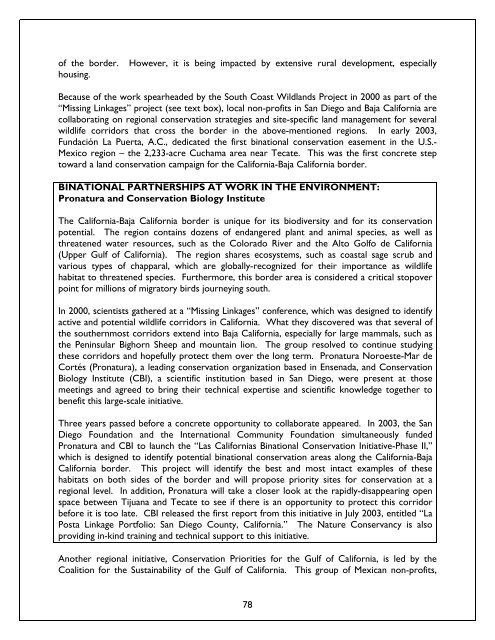Blurred Borders - International Community Foundation
Blurred Borders - International Community Foundation
Blurred Borders - International Community Foundation
You also want an ePaper? Increase the reach of your titles
YUMPU automatically turns print PDFs into web optimized ePapers that Google loves.
of the border. However, it is being impacted by extensive rural development, especially<br />
housing.<br />
Because of the work spearheaded by the South Coast Wildlands Project in 2000 as part of the<br />
“Missing Linkages” project (see text box), local non-profits in San Diego and Baja California are<br />
collaborating on regional conservation strategies and site-specific land management for several<br />
wildlife corridors that cross the border in the above-mentioned regions. In early 2003,<br />
Fundación La Puerta, A.C., dedicated the first binational conservation easement in the U.S.-<br />
Mexico region – the 2,233-acre Cuchama area near Tecate. This was the first concrete step<br />
toward a land conservation campaign for the California-Baja California border.<br />
BINATIONAL PARTNERSHIPS AT WORK IN THE ENVIRONMENT:<br />
Pronatura and Conservation Biology Institute<br />
The California-Baja California border is unique for its biodiversity and for its conservation<br />
potential. The region contains dozens of endangered plant and animal species, as well as<br />
threatened water resources, such as the Colorado River and the Alto Golfo de California<br />
(Upper Gulf of California). The region shares ecosystems, such as coastal sage scrub and<br />
various types of chapparal, which are globally-recognized for their importance as wildlife<br />
habitat to threatened species. Furthermore, this border area is considered a critical stopover<br />
point for millions of migratory birds journeying south.<br />
In 2000, scientists gathered at a “Missing Linkages” conference, which was designed to identify<br />
active and potential wildlife corridors in California. What they discovered was that several of<br />
the southernmost corridors extend into Baja California, especially for large mammals, such as<br />
the Peninsular Bighorn Sheep and mountain lion. The group resolved to continue studying<br />
these corridors and hopefully protect them over the long term. Pronatura Noroeste-Mar de<br />
Cortés (Pronatura), a leading conservation organization based in Ensenada, and Conservation<br />
Biology Institute (CBI), a scientific institution based in San Diego, were present at those<br />
meetings and agreed to bring their technical expertise and scientific knowledge together to<br />
benefit this large-scale initiative.<br />
Three years passed before a concrete opportunity to collaborate appeared. In 2003, the San<br />
Diego <strong>Foundation</strong> and the <strong>International</strong> <strong>Community</strong> <strong>Foundation</strong> simultaneously funded<br />
Pronatura and CBI to launch the “Las Californias Binational Conservation Initiative-Phase II,”<br />
which is designed to identify potential binational conservation areas along the California-Baja<br />
California border. This project will identify the best and most intact examples of these<br />
habitats on both sides of the border and will propose priority sites for conservation at a<br />
regional level. In addition, Pronatura will take a closer look at the rapidly-disappearing open<br />
space between Tijuana and Tecate to see if there is an opportunity to protect this corridor<br />
before it is too late. CBI released the first report from this initiative in July 2003, entitled “La<br />
Posta Linkage Portfolio: San Diego County, California.” The Nature Conservancy is also<br />
providing in-kind training and technical support to this initiative.<br />
Another regional initiative, Conservation Priorities for the Gulf of California, is led by the<br />
Coalition for the Sustainability of the Gulf of California. This group of Mexican non-profits,<br />
78















